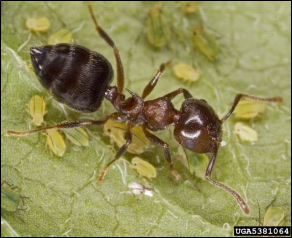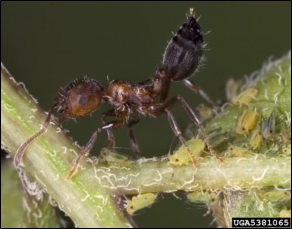Acrobat Ant
ID
ENTO-405NP
Identification
Several species of ants in the genus Crematogaster are collectively known as the acrobat ants. They are native species of ants commonly found in Virginia. Acrobat ants are small, shiny, reddish-brown to black in color (Fig. 1). They generally measure 2-3 mm (about 0.1 inch) long. The heart-shaped abdomen is flattened on top but rounded underneath. Acrobat ants get their common name from their habit of holding their abdomens up in the air defensively when they are disturbed (Fig. 2).
Hymenoptera: Formicidae, Crematogaster spp.

Life History
Acrobat ants have a complete life cycle consisting of an egg, larval, pupal, and adult stages. The immature stages (eggs, larvae, and pupae) require significant brood care by adult worker ants.
Like other ant species, acrobat ant colonies exhibit a division of labor among the adult ants. There are worker ants that tend the immature brood, forage for food, and perform housekeeping chores in the colony. Soldier ants defend and protect the colony. The queen ant, which founded the colony, lays eggs that develop into workers, soldiers, and reproductive ants. When colonies are mature and the environmental conditions of temperature and humidity are right, the winged reproductive males and females leave the nest on mating flights. Mated queen ants will disperse to start their own colonies in suitable locations. Swarms of winged reproductive acrobat ants in a house indicate that there is an acrobat ant nest in or close by the house.

Acrobat ants frequently nest above the ground in tree cavities and galleries made by other animals or insects, or in standing stumps or tree snags. They also nest in structures that have moisture-damaged and rotten wood. Other acrobat ant nest sites include old carpenter ant nests; empty termite galleries; old stacked firewood that isn’t kept dry; or on the ground under logs or rocks.
Acrobat ants are omnivorous, consuming both protein and sugar foods. They prey on small insects and scavenge dead insects or carrion. They also eat seeds, feed on floral nectar, and collect honeydew from aphids and similar insects (Fig. 1).
Description of Damage
Acrobat ants are common home invaders. They often enter homes through small cracks and openings around window frames, door jambs, and roof vents. They may use tree limbs to get onto roofs. Inside houses, they may nest in insulation, wall voids, or under siding. Frequently they nest in materials that were previously water damaged, such as rotten wood around windowsills, skylights, gutters, and drains.
Acrobat ant colonies may go unnoticed until piles of dead ants, parts of their insect prey, sawdust-like powder, or bits of building materials accumulate and attract attention from home owners. This debris results from acrobat ants cleaning debris out of their nests. Acrobat ants may use old carpenter ant galleries as their nests, but they do not cause significant structural damage like carpenter ants or termites.
Control
If the acrobat ant nest can be located and exposed with minimal damage, spray the nest with an aerosol or liquid insecticide. See the latest Virginia Pest Management Guide for Home Grounds and Animals (VCE 456-018) for current insecticide recommendations on controlling ants in and around the home. In some situations, an insecticidal dust may be appropriate for ant nests in structural voids; consult a licensed pest control operator regarding this treatment.
If the acrobat ant nest cannot be reached because it is located in a physically inaccessible area, baits are a good choice for control. Baits labeled for sugar feeding ants are appropriate for acrobat ants. Place baits in areas with large numbers of foraging ants. Foraging ants lay scent trails to mark paths for foods; placing the baits where workers are foraging will result in more workers discovering the bait. Several baiting sessions may be necessary to reduce the number of foraging workers. Keep baits available until foraging ants are no longer seen. Good home maintenance can limit acrobat ants from invading a house by reducing the places the ants can enter the house. Keep tree limbs, shrubs, and vines away from foundations, siding, and roofs. Seal any exterior cracks and crevices around windows and doors, or in the foundation or attic spaces. Be sure to seal gaps around places where wiring and pipes enter homes. Do not store firewood beside houses or on front porches. Reduce and remove any clutter, dead stumps, or any wood in the yard around the house that may attract nesting ants.
Because acrobat ants are attracted to moisture- damaged wood, their presence may indicate that there are leaks in the roof or a leaky water pipe in the walls. These situations should be addressed in addition to controlling the ants themselves. Keep skylights, flashing, and gutters in good repair, and replace any rotten wood when found.
Virginia Cooperative Extension materials are available for public use, reprint, or citation without further permission, provided the use includes credit to the author and to Virginia Cooperative Extension, Virginia Tech, and Virginia State University.
Virginia Cooperative Extension is a partnership of Virginia Tech, Virginia State University, the U.S. Department of Agriculture (USDA), and local governments, and is an equal opportunity employer. For the full non-discrimination statement, please visit ext.vt.edu/accessibility.
Publication Date
January 29, 2021



